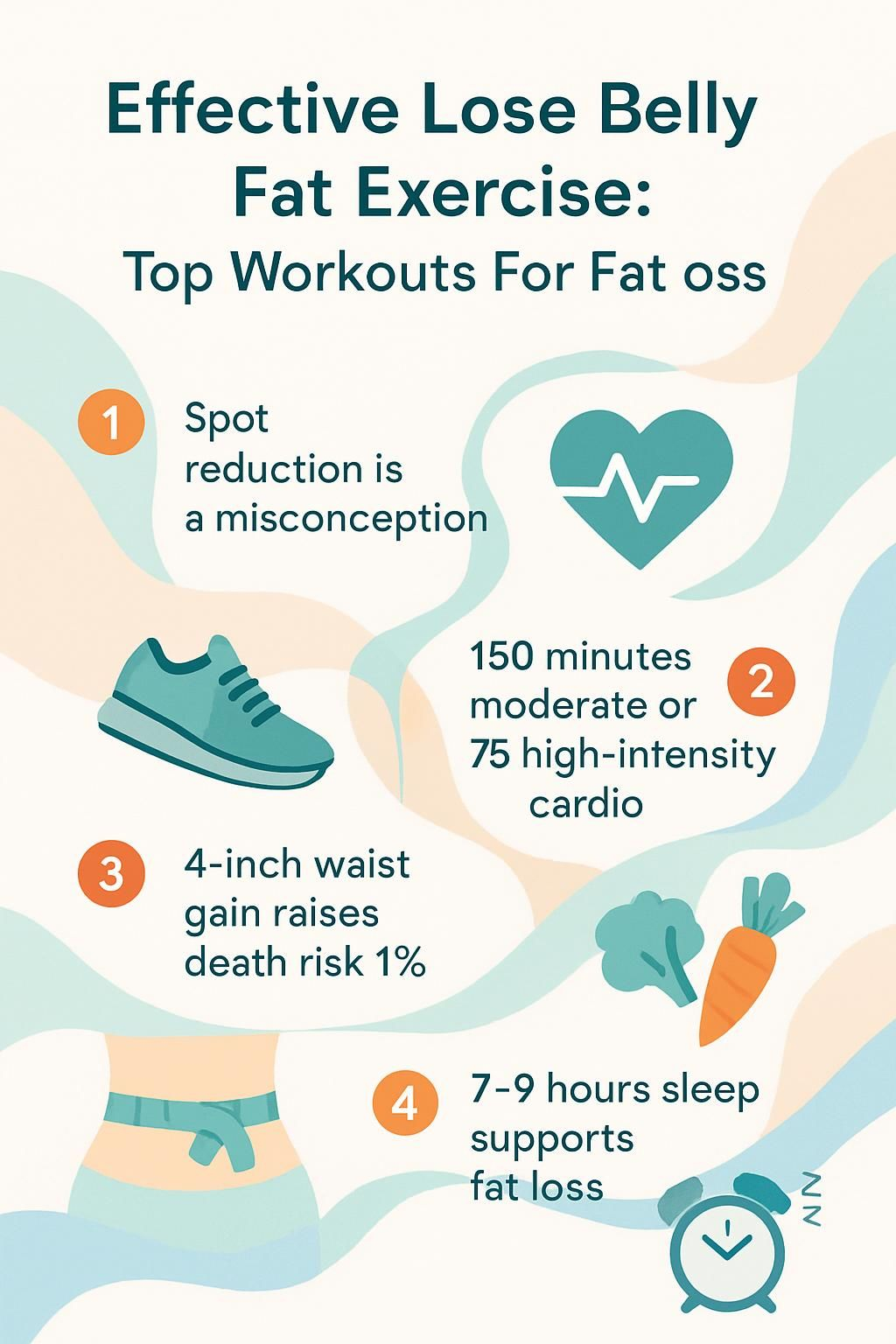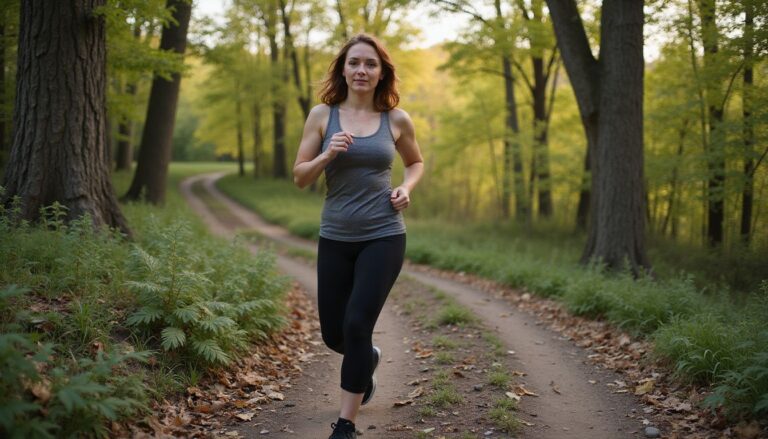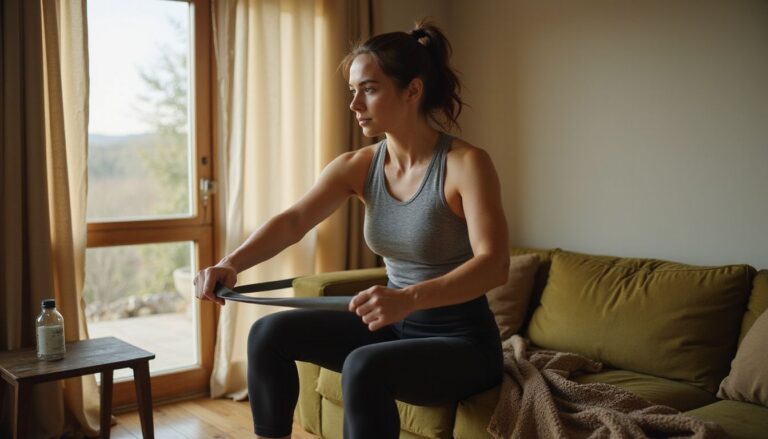Effective Lose Belly Fat Exercise: Top Workouts For Fat Loss
Our Nutrition Assistant AI Suite will transform your body. You will lose fat, get toned, and build muscle. Gain confidence and optimal health.
Struggling with stubborn fat around your belly can feel discouraging. You are far from alone. Extra fat in this area raises your risk for heart disease and type 2 diabetes.
Effective lose belly fat exercise routines, paired with smart daily habits, help you burn more calories and protect long‑term health. This guide highlights the best workouts, practical tips, and key facts in plain language. Use it to make steady progress with less guesswork.
Keep reading for proven, safe ways to reduce belly fat and feel stronger.
Key Takeaways
- Spot reduction is a myth. You lose belly fat through whole‑body fat loss with cardio, strength training, and HIIT, as shown by CDC guidance and research from Harvard.
- CDC recommends weekly activity of 150 minutes moderate cardio or 75 minutes vigorous cardio. Add strength training at least two days per week to raise metabolism and support fat loss.
- Higher visceral fat, which often grows with each 4‑inch waist gain, is linked to an 11% higher risk of early death, according to a BMJ study. It is also tied to heart disease, diabetes, and some cancers.
- Eating more fiber, limiting sugary drinks, and cutting processed foods can improve insulin sensitivity and reduce visceral fat, notes the American Heart Association (2023).
- Quality sleep, about 7 to 9 hours nightly, and stress control help balance cortisol. This supports lasting belly fat reduction.

Understanding Belly Fat Types and Risks

Belly fat comes in two main types, subcutaneous fat under the skin and visceral fat deep inside the abdomen. Too much of either can harm health, but visceral fat carries higher risk.
What is the difference between subcutaneous and visceral belly fat?
Subcutaneous fat sits just under your skin. You can usually pinch it around the waist, hips, or thighs. It stores energy and affects appearance more than health for most people.
Visceral fat wraps around internal organs like the liver and pancreas. It is more metabolically active, which means it can disrupt hormones and raise disease risk. High visceral fat links to heart disease, high blood pressure, diabetes, and some cancers.
A quick check, measure your waist at the navel. A larger waist often signals higher visceral fat.
Why is excess belly fat dangerous to your health?
Excess belly fat, especially visceral fat around your organs, raises the risk of serious problems. Harvard experts connect it with high blood pressure, high cholesterol, heart disease, type 2 diabetes, stroke, breathing issues, and breast cancer.
Visceral fat can raise cortisol, a stress hormone, and disturb normal hormone balance. A BMJ study reported that each 4‑inch increase in waist size was linked to an 11 percent higher risk of early death. Researchers from the University of Toronto also note that waist measurement may predict risk better than body mass index.
Abdominal obesity can make it harder to control insulin and blood sugar. That increases your chance of diabetes and blood vessel damage. Lowering visceral fat is a strong step for long‑term health.
Next, learn whether specific exercises can target fat only around the abdomen.
Can You Target Belly Fat with Specific Exercises?
Many people look for exercises to lose belly fat in a single area. Research shows that full‑body training burns more calories and reduces fat more reliably.
Is spot reduction of belly fat a myth?
Spot reduction is a myth. Ab moves like crunches strengthen muscles but do not burn fat only from the abdomen. Fat loss happens when you reduce total body fat with a balanced diet, regular exercise, and healthy sleep and stress habits.
In one 2011 trial, people did hundreds of ab exercises for weeks. Their abdominal fat did not drop more than fat in other areas.
Experts agree that a mix of cardio, strength training, and smarter eating drives the best results. Core work builds strength, but it is not a direct fat burner for one spot.
Abdominal exercises can tone your stomach muscles but do not reduce visceral or subcutaneous belly fat on their own.
To reduce belly fat effectively, center your plan on full‑body workouts.
Why are full-body workouts essential for fat loss?
Full‑body workouts engage many muscles at once. That raises your heart rate, increases calorie burn, and supports fat loss during and after training. Moves like deadlifts, burpees, thrusters, and kettlebell swings also build muscle mass.
More muscle increases resting metabolism, so you burn more calories even at rest. The CDC suggests at least 150 minutes of moderate cardio or 75 minutes of vigorous cardio each week. Pair that with strength training two or more days per week.
After months of only ab work with little change, I added squats, push‑ups, and short HIIT circuits. The shift finally moved the scale and trimmed my waist.
Best Cardio Exercises for Burning Belly Fat
Cardio raises heart rate and metabolism. These workouts use large muscle groups, which helps you burn calories and lose fat across the body, including around your belly.
How does brisk walking or jogging help burn belly fat?
Brisk walking or jogging for at least 30 minutes a day helps create a calorie deficit, the key driver of fat loss. These low‑impact options fit most fitness levels and are easy to start.
Meeting the 150‑minute weekly cardio target with walking or jogging supports steady fat loss. Time outdoors can also lower stress, which may reduce cortisol‑related fat gain.
As consistency improves, your body taps fat for fuel more often. That supports gradual reductions in both subcutaneous and visceral fat. A daily walk is a simple habit with real payoff.
What are the benefits of cycling for fat loss?
Cycling burns calories efficiently and protects your joints. You can ride outside or use a stationary bike at home or the gym. Many people add cycling to their commute for built‑in activity.
Group rides and classes boost motivation. Over time, consistent cycling improves cardiovascular fitness and helps reduce body weight and deep abdominal fat.
How does swimming contribute to belly fat reduction?
Swimming blends resistance and cardio in one session. Each stroke engages the core, legs, arms, shoulders, and back. Water adds natural resistance, so you burn many calories with less joint stress.
Short daily swims of about 30 minutes can meet activity guidelines. Studies show swimming increases total energy use and helps reduce visceral fat that surrounds the heart and liver.
After an ankle sprain stopped my runs, I switched to laps three times a week. Training in water kept me pain free and still trimmed my waist as my diet improved.
What makes High-Intensity Interval Training (HIIT) effective?
High‑Intensity Interval Training, or HIIT, uses short bursts of tough effort followed by equal rest. Moves can include jumping jacks, burpees, push‑ups, jump squats, or high knees. A typical burst lasts 20 to 40 seconds.
HIIT burns many calories in little time and can raise calorie burn after the workout, known as excess post‑exercise oxygen use. Effective sessions can take 15 to 20 minutes.
Beginners can start with 15 to 20 reps per move at a comfortable pace. Many people see faster waist changes by adding HIIT to their weekly routine, instead of only steady cardio.
Strength and Core Workouts to Target Belly Fat
Strength and core training build muscle and improve posture. More muscle helps you burn more calories all day, which supports fat loss over time.
How do mountain climbers help in losing belly fat?
Mountain climbers combine a plank with fast knee drives. The move works your shoulders, chest, core, glutes, and legs while spiking your heart rate. It delivers cardio and strength in one simple drill.
No equipment is required. Clear some space and aim for 15 to 20 reps per side to start. As pace and control improve, calorie burn rises and core stability grows.
Why are planks effective for core strength and fat loss?
Planks build deep core stability without equipment. Holding a plank for 30 to 60 seconds works your abs, back, shoulders, and legs at the same time. This full‑body tension burns more calories than many isolated ab moves.
Planks also improve posture, which can reduce back strain. As you increase hold time or try variations, like side planks or toe taps, your metabolism gets a helpful boost.
How do deadlifts contribute to belly fat reduction?
Deadlifts train large muscle groups, mainly the legs, glutes, back, and core. Working many muscles increases calorie burn during the lift. Gaining muscle from deadlifts also raises your resting metabolism.
Better posture and trunk strength make daily movement safer and more efficient. You can use dumbbells or a barbell, adjusting weight as your form improves.
What is the benefit of squat jumps for fat burning?
Squat jumps are a plyometric move that raises heart rate quickly. The explosive effort uses your legs and core, so you burn more energy in less time. They fit well into circuits or HIIT sessions and need no equipment.
For beginners, try sets of lower reps with full control. Good form matters more than speed.
Top Abdominal Exercises for a Stronger Core
Targeted core work supports a stable spine and better movement. Combine these exercises with full‑body training for the best chance to reduce waist size over time.
How does the spinal twist improve core strength?
Spinal twists target the obliques, the muscles along your sides. They build rotational strength and improve torso flexibility. You can do them seated or standing, with or without light weight.
Better rotational control helps in sports and daily tasks. A balanced core also supports good posture during longer walks or rides.
What are the benefits of leg raises for your abs?
Leg raises strengthen the lower abdominals and hip flexors. Lying leg raises support pelvic alignment when you keep a neutral spine. Aim for 10 to 15 reps per set, resting as needed.
To increase difficulty, add reps or hold a small weight between your feet. Take care to move slowly and avoid arching your back. Many people notice better core control and fewer aches after a few consistent weeks.
How does the side plank with rotations target belly fat?
The side plank with rotations challenges the obliques and deep stabilizers. Lifting the hips and rotating the upper body increases the demand on your trunk. This raises total calorie burn and strengthens muscles that support the waist.
Hold for up to 60 seconds per side, or shorten the time if needed. The skill carries over to daily movements like lifting and reaching.
Why are bicycle crunches effective for core workouts?
Bicycle crunches work the upper abs, lower abs, and obliques together. Research shows they activate more core muscles than many standard crunches. That can improve endurance and muscle tone with no equipment.
Slow the tempo for more control and tension. Add 12 to 20 reps to a circuit for an extra core challenge.
Full-Body Exercises to Boost Metabolism
Full‑body moves are time savers. They use many muscles at once, which increases calorie burn during the workout and supports a higher metabolism afterward.
How do burpees increase fat burning?
Burpees combine a squat, plank, push‑up, and jump into one powerful move. Just 10 strong reps can feel like a short sprint. They need no equipment and train the whole body fast.
Because so many muscles work at once, energy use climbs quickly. Burpees are common in HIIT sessions since they can boost calorie burn long after you stop.
What are thrusters and how do they help fat loss?
Thrusters pair a squat with an overhead press using dumbbells or a barbell. The movement trains legs, glutes, shoulders, and arms in one smooth pattern. That combination drives heart rate up and burns many calories.
Use thrusters in circuits or intervals for both strength and cardio gains. Start with lighter weight and focus on a full squat and a stable press overhead.
Why are kettlebell swings good for metabolism?
Kettlebell swings are a hip‑hinge move that uses your glutes, hamstrings, back, and core. The explosive swing teaches power while challenging grip and posture. High‑rep sets fit well in short conditioning workouts.
As your technique improves, the exercise becomes a safe, effective way to condition your whole body in minutes.
How does the farmers walk improve fat burning?
The farmers walk is simple and tough. Hold heavy weights at your sides and walk 10 to 20 meters. This trains your legs, core, shoulders, and grip while elevating heart rate.
Loaded carries can improve posture and build functional strength. Increase distance or weight gradually to keep progress steady and safe.
How to Incorporate These Workouts into Your Routine
Planning your week helps turn exercise into a habit. Small, consistent steps beat all‑or‑nothing bursts.
How can you create a weekly workout schedule?
Build a weekly plan that blends cardio, strength work, and one or two HIIT sessions. Spread harder days apart to allow recovery. Include enjoyable options like walking, cycling, or swimming so you stay consistent.
Example schedule:
- 2 to 3 days cardio, such as brisk walking, jogging, or cycling, 30 to 45 minutes
- 2 to 3 days strength training for major muscles, 30 to 45 minutes
- 1 to 2 short HIIT sessions, 15 to 20 minutes
- 1 to 2 rest or active recovery days, light stretching or easy walks
Track sessions in a simple chart. Write the exercise type and time for each day. This clarity makes it easier to stick with the plan.
How do you balance cardio and strength training effectively?
Alternate cardio days with strength days, or combine both in circuits. For instance, schedule cycling on Tuesday and Thursday, and full‑body lifting on Monday and Friday. Circuit training can blend short cardio bursts with sets of squats, rows, and planks.
Vary intensity through the week. Try one HIIT day, one steady‑state cardio day, and one moderate day. Watch for signs of overtraining like constant fatigue or unusual soreness. Adjust volume if needed.
Why is rest and recovery important for fat loss?
Recovery helps your muscles repair and your hormones reset. Skipping rest can raise cortisol, which may slow fat loss and hurt sleep. Aim for at least one or two rest days every week.
Quality sleep supports muscle repair and keeps appetite hormones in balance. If workouts start to feel worse, reduce intensity for a few days and focus on sleep, hydration, and nutrition.
Lifestyle Changes to Support Belly Fat Loss
Exercise works best with healthy eating, stress control, and solid sleep. Think of these habits as support beams for your results.
What dietary changes help reduce belly fat?
Create a modest calorie deficit. Fill most meals with vegetables, beans, fruit, whole grains, and lean protein like chicken, fish, eggs, or tofu. Build plates that are half vegetables, one quarter protein, and one quarter smart carbs.
Limit sugary drinks and highly processed snacks. Keep portions moderate to control calories without strict rules. Planning simple meals ahead makes better choices easier.
The American Heart Association reports that higher fiber intake increases fullness and supports healthy cholesterol levels. Lower added sugar can improve insulin sensitivity and help reduce visceral fat around organs like the liver.
A small change can help. Years ago, I swapped soda for water on work breaks. Energy improved within weeks and it was easier to stick with better food choices.
How does reducing processed foods and sugars aid fat loss?
Processed foods often hide extra sugar and fat. Those calories add up fast. Cutting them lowers total intake and helps manage hunger.
Research links sugar‑sweetened drinks with more belly fat. Choose water, unsweetened tea, or coffee. Read labels and watch for added sugars like corn syrup or maltose.
What are effective ways to manage stress for fat loss?
High stress can elevate cortisol, which is tied to increased belly fat. Short daily practices help. Try 5 minutes of deep breathing, a short walk, or a quick stretch break.
Set realistic goals and lean on social support. Even a brief chat with a friend can reset your stress response and your mindset.
Why is quality sleep important for losing belly fat?
Short sleep can disrupt ghrelin and leptin, hormones that control appetite. That often leads to stronger cravings and more snacking. People who sleep less than 6 hours per night tend to carry more visceral fat than those who sleep 7 to 9 hours.
Keep a steady bedtime, reduce screens before bed, and make your room dark and cool. Better sleep helps your body manage energy and preserve muscle from training.
Important Safety Tips for Exercising
Safe training keeps you consistent. A few simple habits protect progress and prevent setbacks.
Why should you warm up and cool down during workouts?
Warming up prepares muscles and joints, which reduces strains and sprains. Spend 5 to 10 minutes on dynamic moves like arm circles, light jogging, or bodyweight squats.
Cooling down helps heart rate return to normal and cuts dizziness. Gentle stretching improves flexibility and may reduce next‑day soreness.
How can you stay properly hydrated while exercising?
Drink water before, during, and after workouts. Keep a bottle nearby and sip regularly during squats, intervals, or rides.
Check urine color. Pale yellow suggests good hydration, while dark yellow signals you need more fluids. On longer or hotter sessions, consider an electrolyte drink to replace minerals lost in sweat.
When should you consult a professional before exercising?
Talk with a healthcare professional if you have heart disease, diabetes, or uncontrolled high blood pressure before starting new training. Medical guidance keeps your plan safe.
If you have past injuries or pain, ask a clinician or physical therapist for modifications. New to exercise, work with a certified trainer to learn proper form and reduce injury risk.
Pain that does not go away during a workout is a signal to stop and seek help.
Conclusion
Losing belly fat takes consistent action, not quick fixes. Use a mix of cardio, strength training, and core work to burn calories and build muscle. Spot reduction is not possible, so aim for whole‑body fat loss with the best exercises you can sustain.
Support your workouts with a high‑fiber, lower sugar eating pattern, steady sleep, and simple stress tools. Stick with the plan. Each small step helps reduce visceral fat and improves health over time.
This article offers general information, not medical advice. Consult a qualified professional for personal guidance, especially if you have a medical condition or take medications.
FAQs
1. What is the most effective exercise to lose belly fat?
Squat (exercise) is one of the most effective workouts for fat loss. It targets major muscle groups, increases calorie burn, and can improve overall health. Studies show that compound movements like squats help reduce abdominal fat when combined with a balanced diet and regular activity [1].
2. How does squat (exercise) help improve overall health?
Squat (exercise) strengthens the lower body, supports core stability, and boosts metabolism. Research indicates that regular squats can improve cardiovascular health, support joint function, and help maintain a healthy weight [2]. These benefits contribute to better fat loss outcomes.
3. Are there other workouts besides squat (exercise) that help with fat loss?
Yes, exercises such as brisk walking, cycling, and interval training also support fat loss. However, squat (exercise) remains a top choice because it engages multiple muscle groups and can be adapted for various fitness levels. Combining squats with other activities can further improve overall health and fat reduction.
4. How often should I perform squat (exercise) for best fat loss results?
Experts recommend performing squat (exercise) two to three times per week. Consistency is key. Pairing squats with a healthy diet and other physical activities can maximize fat loss and improve overall health. Personal experience shows that regular squats, along with mindful eating, lead to visible results within a few months.
Summary: Squat (exercise) is a proven workout for losing belly fat and improving overall health. Combining squats with other exercises and a balanced diet increases the chance of success. Consistent effort and proper form are essential for the best results.
References:
[1] Harvard Health Publishing. “The truth about belly fat.”
[2] American Council on Exercise. “Squats: Benefits and Techniques.”







